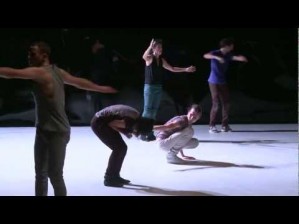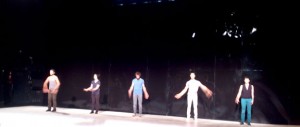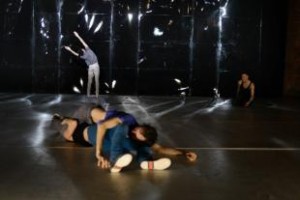
In Meg Stuart’s citing of herself: “often I say to my dancers: Your body is not yours.â€2 (link) lingers a resonance quite close to Spinoza’s â€what the body can do†– “the body itself, merely from the laws of its own nature alone, can do many things, at which the mind marvels.â€3
Stuart’s 2011 piece ‘Violet’ reminds of excessive body exploration as also obvious in some footage scenes of the recently released memorial film that show the nervous power of the adamant dancer Tania Liedtke after her accidental death in 2007. But it is Stuart’s basic decision to build on the abstraction of bodily features which lead to the unique experience of that piece under the specified title. The choosing of the title as the name of a color that is close to the outer range of the color spectrum appears thus rather appropriate to describe something that somehow is known for being there, but cannot really be perceived or grasped. Well, in fact it even points out that, what we see in this piece, is still within the visible spectrum.
The work is an energetic dance or better movement piece, that through a bodily ‘voicing’(a sort of toning) of the five dancer’s gestures tries to express the furious power of a storm. Stuart describes that the challenge of the piece has been to strip movements down to abstraction, though to avoid an analytical approach but to enforce and communicate instead a sort of ‘rock ‘n roll’ feeling. And still this description sounds as paradox as the task is itself.

Only slowly, step by step, one by one, the dancers start to move into the room. Moving as such, in terms of covering a distance or deciding on a direction, indeed seems not to be their main intension. Movement here is understood as body energy, which translates directly to expressions of certain energetic move/gesture variations of an energized matter. Singular and small gestures evolve into more extensive ones or just cross-cutting convulsions, motion that seems to generate itself, emerging without obvious cause, out of any specific reason. Movements that come out to be defined and justified by their very own – could it be: the body’s own (e)motions. Would that really be, mean, look alike ….?
trailer ‘VIOLET‘ / youTube
Meg Stuart is cited in the program leaflet, as that she “began looking at energetic patterns in nature and at alchemic symbols†and †.. in terms of the dancers being on a ritualistic journey.†These excerpts seem to be quite corresponding, but the piece goes further. By its intention to play “with ideas of trying to harness kinetic energy and imagining the havoc it could wreak†it attempts to reach an almost ‘pure’ movement(if there is such), emerging into a space covered/created by sound. The composer and drummer Brendan Dougherty creates a sound that is not really equivalent to the notorious MMM of Lou Reed . But at least some of its impertinence recalls the just passed away initiator of the sonic experiment. All together, the excessive bodily moves, as well as the sound wall recall motion as the energetic address of body senses (vision and sound) and mind creating what might look as a ‘thought-free’ space of muscle contractions. An experience of a different kind.
It seeks for motion that is not limited to the basic idea of moving, as to change a spatial or sensual position from one to another point or state. But one that concerns moves in any sense, especially those of mental understandings of thinking, as well of those of immersive hearing, as an intense experience along the thin dividing and simultaneously intersecting line of pain/pleasure. One could easily fall to one side or the other. Though obviously the somewhat breath-taking (and may it only be to fear for the dancer) experience attempts to balance on that thin rope to neither fall to any side, but to explore the shaking e/motions that lead to dance and are mirrored in the audience’s movement experience.
Indeed the piece draws us, as the audience, in by its ascending furor that is first only supported, but later aggressively driven by an opaque wall of sound that not only chases the dancers to extremes, but also makes the drum felt in the bodies of the audience. It overpowers the heavy breathing of dancers but cannot obscure the sweating bodies, the wet T-shirts and pale or red faces. The body shows its strains, demands attention.

In the end it is almost one climax too much – and the relief is a thoroughly felt one. The storm is over, the mind cleared, the bodies revive … and slowly the dancers recover their smile. All this together made up the exciting experiment this performance is. Thank you.
Footnotes:
headline: taken from the HAU program of the Violet performance in October 2013, Meg Stuart / Damaged Goods
2 From Meg Stuart / Damaged Goods website intro
3 B. Spinoza, Ethics. III. prop. 2, note
4 http://utopiaparkway.wordpress.com/2011/07/21/shellshocked-but-extremely-alive-five-dancers-in-an-abstract-maelstrom-that-sweeps-you-away-meg-stuarts-violet/
